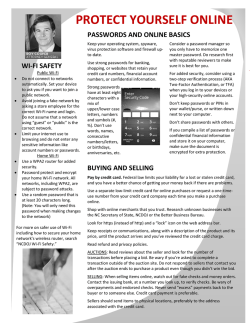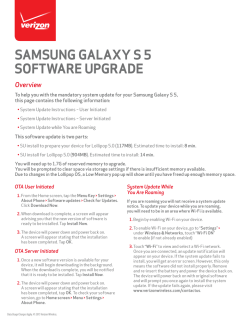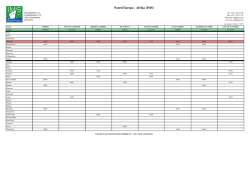
Wi-Fi calling – extending the reach of VoLTE to Wi-Fi
The communications technology journal since 1924 Wi-Fi calling – extending the reach of VoLTE to Wi-Fi January 30, 2015 2015 • 1 Carrying IMS voice and video calls over Wi-Fi 2 Wi-Fi calling – extending the reach of VoLTE to Wi-Fi Using untrusted Wi-Fi to carry voice and video communication is an open opportunity for operators to extend VoLTE/ViLTE services in, for example, indoor locations where cellular coverage may be spotty. L E N NA RT NOR E L L , A N DE R S LU N D S T RÖM , H Å K A N Ö S T E R LU N D, H E N R I K JOH A N S S ON A N D DA N I E L N I L S S ON Operators worldwide are currently launching IMS-based voice and video calling over LTE (VoLTE and ViLTE) services, supported, for the moment, by about 70 commercially available mobile devices. Recently, a new technology was developed to carry voice and video calls over Wi-Fi. This solution, referred to as Wi-Fi calling, extends VoLTE by including support for Wi-Fi as an access type for both voice and video calls. Wi-Fi calling is closely aligned with VoLTE; it uses the same IMS telephony client, and supports mobility between LTE and Wi-Fi accesses, making the resulting user experience a seamless one. Handover of calls between LTE and Wi-Fi is enabled by routing Wi-Fi calling traffic to the IMS through the Evolved Packet Core (EPC), which results in a scalable deployment opportunity for network operators. As illustrated in Figure 1, Wi-Fi access can be used for telephony services for several subscriber and enterprise scenarios. However, the bulk of current implementations and the primary use case for Wi-Fi calling is to complement indoor environments where cellular network coverage is limited. This use case may also apply to small business premises. Operators are also considering using this technology to provide users, traveling outside their home network, with access to the IMS telephony services of their home network over Wi-Fi networks that are commonly found in hotels, airports, shopping malls and cafés. Wi-Fi calling offers users a simple solution for voice and video calls – one that is fully integrated with modern smartphones and does not require any additional apps or downloads. As such, the introduction of Wi-Fi calling is expected to have an impact on the use of OTT VoIP solutions, as well as fixed telephony offerings. The architecture As illustrated in Figure 2, the Wi-Fi calling solution follows the same BOX A Terms and abbreviations AAA APN CS CSFB DSL EPC ePDG FMC GTPv2 HSS IKEv2 authentication, authorization and accounting Access Point Name circuit switched CS fallback digital subscriber line Evolved Packet Core Evolved Packet Data Gateway fixed-mobile convergence GPRS Tunneling Protocol version 2 Home Subscriber Server Internet Key Exchange version 2 E R I C S S O N R E V I E W • JANUARY 30, 2015 IPsec IP Security OTT over-the-top PCRF policy and charging rules function PGW packet data network gateway POTS plain old telephone system SIP Session Initiation Protocol STB set-top box TADS Terminating Access Domain Selection ViLTE video over LTE VoIP voice over IP VoLTE voice over LTE architecture blueprint as VoLTE, except for the introduction of an ePDG node in the EPC. Some modifications to the IMS are also necessary to handle the different nature of Wi-Fi compared with LTE and CS accesses. The Wi-Fi calling solution is an extension of the EPC architecture and allows any Wi-Fi network to be used to access the EPC, which the 3GPP standard refers to as untrusted accesses. The ePDG node at the border, which can be found by a device through a DNS lookup, acts as the gateway between the public internet and the rest of the operator’s EPC. To connect to the ePDG over the Wi-Fi/ internet connection, a device uses the IETF protocols IKEv2 and IPsec. These protocols provide the connection with integrity and confidentiality, implying that any type of internet connection, even an open Wi-Fi hotspot, can be secured. The IKEv2 protocol uses the credentials stored on the SIM card to automatically set up the IPsec tunnel between the device and the ePDG. As a result, no additional action is required by the user, which enhances the seamless experience. The ePDG gateway fetches the security keys/vectors and subscription information from the HSS via an AAA node. During the setup of the IPsec tunnel, the ePDG gateway connects to the PGW using the GTPv2 protocol over the S2b interface. To obtain static and dynamic policies, the PGW uses Diameter signaling (over the Gx interface) to the PCRF in the same way as it does for 3GPP accesses. Consequently, applications like the IMS can set up dynamic policies (over the Rx interface) in the same way as they do for LTE access. 3 When a handover takes place between LTE and Wi-Fi, the device retains its IP address, and any policies assigned to the connection will remain intact. Using this solution, the choice of access technology (Wi-Fi or LTE) used to carry the voice/video call is transparent to both the user and the IMS, except for some minor differences in the way call termination and location-based services are handled. For call termination, the IMS network applies Terminating Access Domain Selection (TADS) to determine whether to terminate a call in IMS or to break out to CS. As devices supporting Wi-Fi calling have dual radios – one for cellular and one for Wi-Fi – a device may be simultaneously attached to both networks, which makes TADS more complex. The IMS system needs to keep track of when a device uses Wi-Fi calling for the IMS service, so that a call remains in IMS – even when cellular access for VoLTE calls is not available. For location-based services, Wi-Fi is different from cellular in that it does not use a Cell-ID to assist in positioning. Consequently, location-based services cannot work in the same way over Wi-Fi as they do over LTE, unless position information is adopted or provided by some other means. Key use cases Extending coverage Currently, the main driver for deploying voice and video calling over Wi-Fi is to extend the reach of VoLTE services in situations where there are gaps in cellular coverage. As shown in Figure 3, holes can occur in indoor environments such as suburban homes, but they also arise in densely populated areas where, for example, the use of energy-efficient building materials makes indoor coverage difficult. Typically, Wi-Fi calling uses an existing Wi-Fi router at a customer’s premises. And now, the main smartphone manufacturers have started to include native device support for use of unmanaged Wi-Fi to access the same IMS voice service as in LTE (VoLTE). This allows operators to offer Wi-Fi calling as a complement to VoLTE in locations with coverage issues. This is a better option than, for example, a femtocell, which would require the FIGURE 1 Wi-Fi calling in practice Home Wi-Fi access point Wi-Fi access point Wi-Fi access point Access to operatorprovided services, when roaming 3GPP access Small office/ business with limited 3GPP coverage Seamless handover of voice and video Homes with limited calls between LTE 3GPP coverage and untrusted Wi-Fi Outside home network FIGURE 2 Wi-Fi calling architecture 3GPP Macro 3GPP Micro 3GPP Pico 3GPP radio access Signaling Payload S5/S8 Gx Rx PCRF SGi DNS IMS system PGW Public/ Internet DNS S2b IEEE 802.11 Internet IPsec/ Wi-Fi AP IKE IPsec/IKE ePDG AAA/ DNS HSS E R I C S S O N R E V I E W • JANUARY 30, 2015 Carrying IMS voice and video calls over Wi-Fi 4 FIGURE 3 Coverage holes in indoor environments Cellular coverage Video range EPC ePDG eNB IPSec Internet IPSec installation of a dedicated femto base station, incurring significant installation and maintenance costs. For ViLTE, coverage issues are more accentuated, as video calling demands greater network capacity than voice. In FIGURE 4 Wi-Fi calling Other devices Mobile phones Wireline devices E R I C S S O N R E V I E W • JANUARY 30, 2015 IMS (VoLTE) unfavorable conditions, video calls may only be possible over Wi-Fi (even if voice calls can be carried over the cellular LTE network). Subscribers may also want to force a video call over the Wi-Fi network if the traffic generated is counted as part of their data bucket. Wi-Fi calling can thus be used as a complement to VoLTE, allowing operators to launch IMS-based voice and video calling – even early on in the process of building out LTE coverage – providing an enhanced user experience compared with CS fallback (CSFB). Operators need to be able to control when a voice service should be carried by the cellular network or be provided over Wi-Fi. This is particularly significant when it comes to supporting emergency calls over Wi-Fi. Devices can be steered to use the cellular network in such cases, but if Wi-Fi is being used to provide a voice service when cellular coverage is unavailable, then provisions for handling emergency calls over Wi-Fi are needed. Beyond the home network As Wi-Fi calling connections are routed over the open internet, provided connectivity is available, subscribers can reach their home operator network from anywhere. This capability provides operators with a solution to offer voice services outside of the home network free of roaming charges, using a device’s native telephony client. In other words, users will not have to install any additional applications when traveling outside the reach of their operator’s home network, and using their mobile device will be no different than if they were within reach. Handover between LTE and Wi-Fi is not possible today but specification work is ongoing to enhance this area with support for Wi-Fi in visited networks – in a similar way to VoLTE. Operators can also manage the use of Wi-Fi calling in certain countries to align with local regulations. However, emergency calls should never be carried over the home network, as such calls must be routed to the local emergency services. Legal aspects related to the interception of calls by national authorities may also come into play, as all traffic between the device and the home operator will be encrypted. 5 Fixed mobile convergence Wi-Fi calling offers FMC operators new opportunities to create broader and smarter bundles for subscribers. Today, many households using fixed broadband services also have a fixed phone extension (home number) delivered as a fixed broadband VoIP service or as a traditional POTS. With the introduction of Wi-Fi calling, the home number could be complemented, so that incoming calls to the home number would forward to a number of mobile phones (used by the household occupants). Other types of combined cellular and Wi-Fi devices such as tablets and set-top boxes (STBs) could also have the IMS client and access the VoLTE service using EPC integration, and could also be alerted of calls to the home number. Such household offerings, in which multiple devices and subscriptions are bundled to cover the needs of all household members, will help to increase operator stickiness and reduce churn. Small office application Small enterprises tend to use DSL or fiber through a single access point to connect the internal network to voice and managed-data services, using a variety of SIP phones. Wi-Fi calling enables mobile operators to address the fixed business by means of a fixed-mobile substitution. With this solution, users can retain their well-known fixed extension yet upgrade to Wi-Fi calling and replace their existing fixed phones with smartphones that can also be used outside the business location. This solution also enables the many advanced voice and video calling features, such as short numbers, possible through IMS to be directly applicable to enterprise users, enabling them to enjoy the experience of a modern smartphone within the context of enterprise telephony. Special care, however, needs to be taken, as the unlicensed nature of Wi-Fi imposes limitations on the number of devices that can use a single Wi-Fi access point. Limitations There are numerous challenges when it comes to providing quality voice and video calling over Wi-Fi. The ability to predict or control the performance of FIGURE 5 Wi-Fi calling for small business users Small enterprises (10–15 users) can start using mobile phones instead of fixed phones Upgrade to a modern phone experience in the small office • One phone number • One address book list Video calling capabilities on Android phones a service over Wi-Fi is limited. Users install the Wi-Fi access point, and the resulting voice service quality depends on how well the Wi-Fi network performs. Wi-Fi calling works well in favorable Wi-Fi conditions but issues may arise in scenarios with interference from neighboring access points, if the Wi-Fi network is already heavily loaded, or if the access point covers a large building. In such cases, a better Wi-Fi router may need to be installed. While recent generations of Wi-Fi technology, such as 802.11n or 802.11ac, enable higher data transfer rates, this does not necessarily solve the issue of voice quality; carrying voice over Wi-Fi relies less on bandwidth and more on a reliable and consistent packet delivery between the device and the access point. Techniques that can prioritize real-time media over ordinary data can make a difference, but as media and signaling are embedded in an IPsec connection, it is not obvious that standard techniques will work. Seamless handover in WI-Fi calling is only supported between Wi-Fi and the cellular LTE network. If multiple access points support a location, then mobility within the location is restricted by device and access point capabilities. Typical home Wi-Fi networks tend to exhibit stickiness: a device will stay on a weak Wi-Fi connection even when a better link is availble through another access point. As Wi-Fi access does not provide for network location information, the iOS8 and Android support preferred option for emergency calls is to carry them over cellular access whenever possible. If Wi-Fi is used where no cellular coverage is available, emergency calls may be carried as normal calls. Location can be obtained, for example, through the registered address for the home Wi-Fi access point. Emergency calls for roaming users using Wi-Fi present a particularly challenging scenario. If the local emergency number is recognized by the device, it will itself request an emergency APN that will use the visited cellular network. If, however, the number is not recognized by the terminal, it is the task of the home network IMS to force the device to leave Wi-Fi and establish the emergency call in the visited network. This implies that the IMS network must be able to detect emergency numbers for all locations where roaming using Wi-Fi is enabled. Conclusion The Wi-Fi calling solution enables operators to extend the use of IMS-based VoLTE services to include carrier supported Wi-Fi calling using a residential Wi-Fi network. Wi-Fi calling can be used to address indoor coverage issues – effectively removing the need for residential femto or app-based solutions. Furthermore, Wi-Fi calling provides service for roaming users, as well as offering a means to provide small enterprises with telephony services. E R I C S S O N R E V I E W • JANUARY 30, 2015 Carrying IMS voice and video calls over Wi-Fi 6 Lennart Norell Anders Lundström Håkan Österlund joined Ellemtel in 1977 to work on the development of Ericsson’s AXE system. He moved to Ericsson in 1982 and has since held various management and technical expert positions in the telecom and datacom product areas. He headed the IMS strategic system management and network evolution units during the design of the IMS system and multimedia telephony. He was a key contributor to the OneVoice specification that was adopted by the GSMA as the base for VoLTE, and he has continued to contribute to the GSMA Inter-Working, Roaming Expert Group (IREG), where he is the editor of the IR.94 reference document for video calls over LTE (ViLTE). He currently works as a system expert at Business Unit Cloud & IP. He holds an M.Sc in electrical engineering from Chalmers University of Technology, Gothenburg, Sweden. joined Ericsson in 1999, initially working in 3G packet core system management. He currently works in Product Line Packet Networks as a strategic product manager for EPC. In this role, he is responsible for virtual EPC and convergence strategies for Wi-Fi integration as part of Ericsson’s overall EPC offering. Previously, he was key lead for Ericsson in the development of a 3GPP2 migration path LTE/EPC, and he has spent several years working in the US in various product management positions. is a senior specialist for IMS solutions with focus on accessspecific functions and is a member of the DUNC telephony evolution team. He has been working in different areas at Ericsson since 1984 and with IMS based telephony solutions since 2001. He studied computer science at the Institute of Technology at Linköping University, Sweden. E R I C S S O N R E V I E W • JANUARY 30, 2 01 5 Daniel Nilsson joined Ericsson in 2000 and is a system manager at Product Development Unit Packet Core Systems & Technology. His area of expertise is in packet core integrated Wi-Fi, and he has worked across the organization with technical aspects of the Wi-Fi calling solution. He holds an M.Sc. in computer science from Luleå University of Technology, Sweden. Henrik Johansson is a product manager in IMS, responsible for the VoLTE solution. He has several years of experience working with voice and communication evolution, stretching from Voice over ATM in the late 1990s, followed by Softswitch, and more recently with VoLTE. 7 To bring you the best of Ericsson’s research world, our employees have been writing articles for Ericsson Review – our communications technology journal – since 1924. Today, Ericsson Review articles have a two-to five-year perspective and our objective is to provide you with up-todate insights on how things are shaping up for the Networked Society. Address : Ericsson SE-164 83 Stockholm, Sweden Phone: +46 8 719 00 00 Publishing: Additional Ericsson Review material and articles are published on: www.ericsson.com/review. Use the RSS feed to stay informed of the latest updates. Ericsson Technology Insights All Ericsson Review articles are available on the Ericsson Technology Insights app available for Android and iOS devices. The link for your device is on the Ericsson Review website:www. ericsson.com/review. If you are viewing this digitally, you can: download from Google Play or download from the App Store Publisher: Ulf Ewaldsson Editorial board: Hans Antvik, Ulrika Bergström, Joakim Cerwall, Stefan Dahlfort, Åsa Degermark, Deirdre P. Doyle, Dan Fahrman, Anita Frisell, Geoff Hollingworth, Jonas Högberg, Patrick Jestin, Cenk Kirbas, Sara Kullman, Börje Lundwall, Hans Mickelsson, Ulf Olsson, Patrik Regårdh, Patrik Roséen, Gunnar Thrysin, and Tonny Uhlin. Editor: Deirdre P. Doyle [email protected] Subeditors: Nathan Hegedus, Ian Nicholson and Birgitte van den Muyzenberg Art director and layout: Carola Pilarz Illustrations: Claes-Göran Andersson ISSN: 0014-0171 Volume: 92, 2015 E R I C S S O N R E V I E W • JANUARY 30, 2015 Ericsson SE-164 83 Stockholm, Sweden Phone: + 46 10 719 0000 ISSN 0014-0171 284 23-3252 | Uen © Ericsson AB 2015
© Copyright 2026



